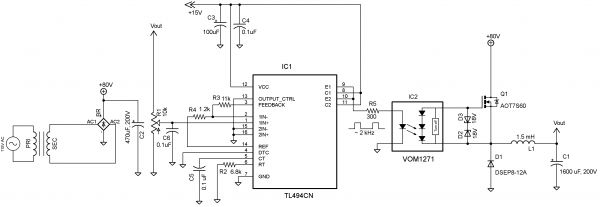Power supplies with adjustable DC output ranging from 0V to 30V or 60V are on the market. Above 60V, there are not many. This Design Idea offers a solution.
There are many fixed voltage switching mode power supplies (SMPS) available, and connecting several in series can give us a higher fixed voltage. To obtain an adjustable output either from a SMPS or conventional transformer based supply, one needs to use a linear regulator or a switchedmode buck converter. For a buck converter, a MOSFET or an IGBT can be used as a switching element.
Usually, for a high side switch, an IC with bootsrap operation or a pulse transformer is used. There are few photovoltaic couplers available to drive MOSFETs. As they do not provide much current to charge the gate capacitance quickly, these photovoltaic couplers are mainly used to drive low frequency MOSFET switches, such as solid state relays.
Here, an attempt has been made to use a photovoltaic coupler (VOM1271) in a switching regulator. This coupler has a built-in fast turn-off device. With a gate capacitance of 200pF connected to IC2, switching times ton and toff are 53µs and 24µs, respectively. Considering this, a switching frequency of 2kHz was chosen for the buck converter. A Texas Instruments TL494 (IC1) was chosen as a pulse-width-modulation controller.
An AOT7S60 MOSFET was chosen as a switching element, considering gate threshold voltage (VGS(th)), total gate charge (Qg), drain-source voltage (VDS), and drain current (ID). As the VOM1271 can provide about 8.4V, VGS(th) should be well below this value; Q1’s VGS(th) is 3.9V, and at 8.4V it is well into conduction. IC2 cannot deliver much current (typically 45µA). To ensure switching speed and reduce switching loss, gate charge should be low. The MOSFET has Qg of 8.2nC.
The buck converter was tested with a step down line transformer output after being rectified and filtered as shown in Figure 1. The output voltage is continuously adjustable from 5V to 70V by varying R1.
Figure 2 shows the gate-source voltage waveform and the IC1 output waveform at 70V output and 230Ω load.
It is seen that though toff is fast enough, ton is about 80µs. This is considered to be a slow turn-on for many switching applications. However, for a switching frequency of 2kHz, it should not cause much switching loss,especially for a load condition when the PWM duty cycle is large.
Though L1 has a smaller value than calculated for the range of output voltage, the ripple was 80 – 120mVP-P for loads ranging from 80Ω – 230Ω. Ripple was 80mVP-P at 70V output and 230Ω load. Line regulation was 0.75% at the same operating condition. Though the efficiency varies with the operating condition, the measured efficiency at VOUT = 70V and IOUT = 0.3A is 92%. Efficiency drops as output current decreases.
Also see:
- Quasiresonant flyback converter easily charges energy-storage capacitors
- HV flyback converter improves efficiency
- High-voltage regulator is 100%-surface-mountable
For more detail: Variable HV power supply employs photovoltaic optocoupler

